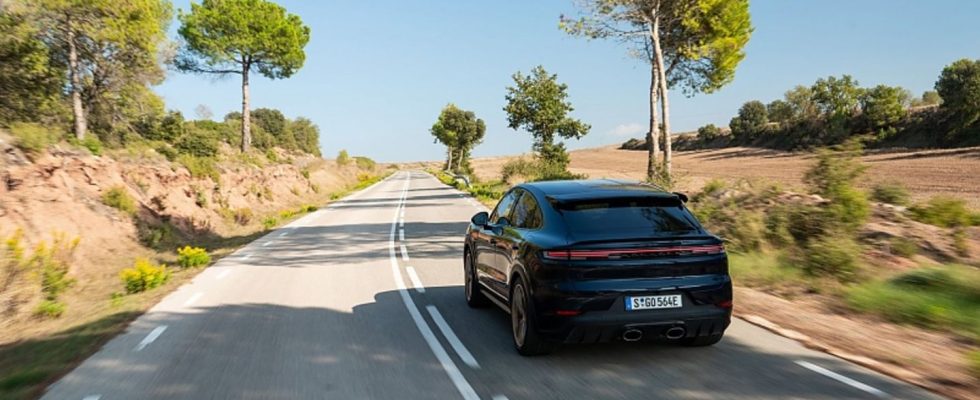Driving report: Cayenne Turbo E-Hybrid Coupé with GT package
Cayenne Turbo E-Hybrid Coupé with GT package
Porsche Cayenne Turbo E-Hybrid Coupé with GT package
© press-inform – the press office
The strict emissions standards are killing the Cayenne Turbo GT in many countries. In its place comes the Turbo E-Hybrid Coupé with GT package, which starts with a powerful 544 kW / 739 hp, but also weighs 2,495 kilograms despite the GT lightweight package.
Cayenne Turbo E-Hybrid Coupé with GT package
At first glance. Because weight is part of every automotive dynamic equation. And despite the GT package, which saves 100 kilograms compared to the regular Cayenne Turbo E-Hybrid, the power Cayenne rolls around the corner with a weight of 2,495 kilograms, which is a good 300 kilograms more than the Italian technology relative Libra brings. The Zuffenhausen diet plan is still impressive: the PCCB brake saves 29 kilograms, the carbon roof saves 21 kg, the wheels save 13 kg, the powerful titanium exhaust system saves 19 kg, and the diet specialists planed the interior by using Racetex (Alcantara), among other things. nine kg, the lithium iron polymer starter battery is twelve kilograms lighter compared to a conventional battery, reducing the wall thickness of the steel pressure tank results in another five kg and two kilograms less insulation.
This power SUV completes the sprint from a standstill to 100 km/h in 305 seconds. That’s 0.1 seconds less than its brother without the GT package. The fact that it only stops at 305 km/h fits the image of this super-Cayenne, which can travel up to 71 kilometers purely electrically in this configuration thanks to the 25.9 kilowatt-hour battery (net 21.8 kWh). The operating modes of the part-time power generator are exciting. In Auto-Hybrid and EV mode, the system uses all the energy from the batteries. For Sport, 20 percent remains (instead of 30 percent for the predecessor) and for Sport plus it is 30 percent (predecessor 80 percent). “We want to make the best possible use of the efficiency potential of the drive train,” explains series manager Michael Schätzle. The remaining percentages are intended for the 20-second boost, during which the Cayenne gets the most out of it. With Sport plus, the combustion engine is used by shifting the load point to fill the energy storage units so that the Porsche SUV never runs out of air. Of course, this increases fuel consumption, but the process happens imperceptibly.
That brings us to the next point. The interaction between engine and transmission is significantly improved compared to the Cayenne E-Hybrid that we tested a few months ago. Accelerating is just as smooth and jerk-free as lightly tapping the accelerator pedal. Even though driving a Cayenne on a winding race track feels a bit like cruising around a swimming pool in the Titanic, we still gave it a go. Thanks to the precise and responsive steering, the Torsen all-wheel drive and the almost equal axle load distribution, the Porsche Cayenne Turbo E-Hybrid Coupé can be accelerated in a relaxed manner from any corner, no matter how tight, at any speed. Starting on the straight is out of this world anyway. However, when turning into curves, the impressive weight of the eight-wheeler becomes noticeable in a tendency to understeer. The brakes could also be dosed a little more precisely.
We noticed this especially during the test drive, which also took us through cities, country roads and motorways, when we wanted to decelerate delicately at intersections. The phenomenon is inherent to the system in a recuperation brake. The refreshed Cayenne PHEV shovels energy back into the batteries with a maximum of 88 kW up to a speed of 2 km/h before the analog friction brake intervenes. The predecessor had a speed of 14 km/h. “We have to make the best compromise,” says Michael Schätzle, explaining the coordination between the energy recovery delay through the electric motor and the transition to the classic analog brake. The Porsche engineers have made no concessions when it comes to the chassis, which can easily cope with the heavier weight compared to variants with a pure combustion engine and enables relaxed progress. And this despite the fact that the GT package comes with a higher spring rate, stiffer stabilizers on the front axle and a lowering of the body by ten millimeters.
This is due to the drive, which can operate purely electrically up to 135 km/h upon request. We activated the “Hybrid Auto” driving mode and consumed an average of 6.9 l/100 km on the test drive, which took us through mountain roads, country roads, highways and cities, which is 5.1 l/100 km more than that Factory specification. The Porsche Cayenne Turbo E-Hybrid Coupé with GT package is a well-rounded affair with its comfortable sports seats, which are slightly higher and allow you to get close to the roof if you are over 1.85 meters tall. If it weren’t for the price. The test car costs 229,653.85 euros.

